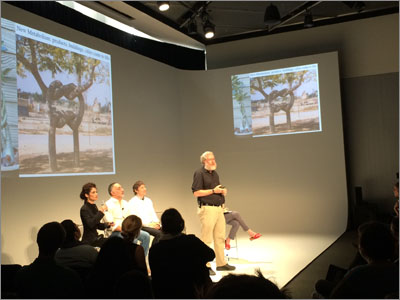Wyss Institute researchers discussed innovative risk-taking in science and contemporary design as panelists at MIT Media Lab’s first summit on design
(CAMBRIDGE, MA) – To imagine the future of mankind, design is one of the most powerful tools we have, according to Kevin Slavin, who is Assistant Professor of Media Arts and Sciences and a curator of Knotty Objects, a summit held by MIT Media Lab dedicated to contemporary design.
The summit gathered together panelists – comprising the world’s pre-eminent designers, architects and scientists – on July 15 and 16 in Cambridge to “explore the apertures and entanglements between and across design and technology”. Included on the expert panel were Wyss Institute Core Faculty member George Church and Wyss Technology Development Fellow Kevin Esvelt.
Although breakthroughs in technology can cause pause for analyzing the ethical and societal implications of our human innovations, the panelists returned to one underlying sentiment over and over throughout the day. That the risks associated with the frontier of discovery – the fears that scientists might go too far, that technological advances could backfire – are less of a risk than doing nothing at all to try and mitigate the dire straits currently facing the Earth and its inhabitants. The risk of inaction far outweighs the risk of action.

Past natural biodiversity has diminished at an alarming rate as human urban sprawl, pollution, and deforestation have driven many species to extinction. The auroch, for example, the wild ox ancestor of the today’s much larger and more muscular domestic cattle, went extinct in the 1600s. While the auroch weighed about 370 lbs., through selective breeding today’s domestic cattle can weigh more than 2500 lbs., showing the impact that human design has already had on natural genomes even in an era before genetic engineering.
“We’ve also turned wolves into Chihuahuas and Great Danes,” said Esvelt, speaking on a summit sub-panel called New Dimensions in Organic Design. According to Esvelt, we can look at organisms as either being created through evolutionary design or rational design. And today many of the world’s animals and plants, especially domestic organisms, have been rationally designed to suit human needs. Through this selective breeding, however, today’s domesticated organisms have lost much of their genetic diversity. And that’s where synthetic biology comes in.
“Synthetic biology is designed to save biodiversity,” said another panelist Daisy Ginsberg, who is a designer and artist who leads Studio Alexandra Daisy Ginsberg. There is hope, however, that future biodiversity could increase with the help of synthetic biologists, returning extinct species and perhaps even creating new ones through genetic engineering.
The panelists suggest that design doesn’t just offer alternatives to current problems but also helps us question how we are defining what’s “better”. If we switch our thinking from what is ‘good’ or ‘bad’ to what is ‘right’ or ‘wrong’, the proof of a design’s efficacy can be found in the data.
Metabolic design elements
“We’re basically ‘Venusforming’ Earth,” said Church, describing the transition of Earth’s environment toward a future that might look quite similar to one of the blue planet’s inhospitable and toxic neighbors. With conditions deteriorating here on our home planet, said Church, “we’d be better off terraforming Venus – and Earth too.”
The human impact on Earth has already hit and exceeded a critical point. The gradual piling up of more and more carbon dioxide in our atmosphere has resulted in a pressing need for humans to seek sustainable solutions to energy, production and disposal of goods, and transportation, and to develop technologies to help reverse the damage done to the environment within the Anthropocene. This is essential in order to stabilize the planet for future generations.
“Good design would be to keep us from self-destructing,” said Church, suggesting that the idea of a metabolism is not just about change but also about stasis.
Church, a metabolic engineer who is responsible for inventing numerous biosensors that put control of bacterial metabolisms in the hands of humans, so that the cellular machinery in species like common E. coli can be hijacked to sustainably produce valuable commodities such as pharmaceuticals and fuels, was part of a sub-panel that explored the concept of The New Metabolism.

For example, how can the concept of a metabolism be applied beyond the biological sciences to inspire more sustainable construction and manufacturing of urban landscapes? Urban architecture could benefit from the design and construction of buildings intended to interact with and be infiltrated by their surroundings and human occupants, embracing a design style that sees a cityscape – and the lifeblood of the people and cultures it contains – as more living and breathing than unmoving concrete and steel.
Buildings, in this sense, become part of a city and a society’s metabolism along every step of their development, influencing the way architects decide the origin from and manner in which their materials are created, how sustainably they will function during their use, and even how one day in the future they might be re-integrated – or reversed – into the natural environment once the building’s use is no longer deemed necessary.
Whether organic or inorganic, objects are not just one defined thing but are part of a larger metabolism, they are “knotty” objects that do not begin or end within visual boundaries but extend beyond to impact all organisms, environments and molecules they interact with over the course of their lifetime.